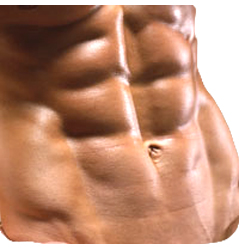Abdominal training may be one of the most frequently misunderstood and neglected aspects of a complete training program. For some unknown reason, a number of misconceptions have developed surrounding ab training that make it extremely difficult for anyone to figure out how to properly train abdominals. Let’s address the three most common myths regarding ab training and discuss how to effectively train our abdominals:

Myth 1. You can change the shape or number of your abs
The shape of your abdominals, i.e. whether they are perfect squares or unsymmetrical, cannot be changed. Similarly, the number of “abs” you have (a 4-, 6-, or 8-pack) will not change with training. While you really only have one “ab” which is just a sheet of muscle, the shape and number of what we call our abs is determined by the location and nature of the connective tissue bands that cross your torso and hold your abdominals in place. These two factors are completely due to luck of the genetic draw.
Myth 2. Ab training will thicken the waist
Concerns of ab training contributing to a larger waistline are incredibly over-exaggerated. How many people do you see with really thick abs and big waists that got them from abdominal training? My guess would be pretty close to none. That being said, one exception to this myth is that I would not recommend an over-abundance of heavy lateral lower oblique work. The reason for this is that once your lower obliques grow, they mistakenly look like love handles. Unless you are involved in specific sports that require substantial lateral stability, minimize the lower oblique work. Upper obliques (those near the serratus) are fine, as they don’t seem to hypertrophy easily anyway.

Myth 3. You can spot reduce fat covering your abs
This has to be one of the most annoying misconceptions of ab training. It’s not uncommon to see people doing literally hundreds of crunches expecting to get a 6-pack when they clearly should be working on losing bodyfat. While you may be able to burn a miniscule amount of abdominal fat doing ab work, it’s clearly ineffective. Very simply, you need to have a low- to moderate amount of bodyfat to see your abs. An exception to this rule (as we’ll discuss below) is people that have very well developed abs. By this I mean they have those chunky thick abs that are still visible when the individual has a significant amount of bodyfat.
So how do we properly train abs?
The answer is deceivingly simple…train them like most other bodyparts! Here are some guidelines:
Reps:
Stick to the same rep ranges you would for most other muscle groups. Make 10-15 rep sets the staple of your ab workouts. It may seem obvious, but the whole point of abdominal training is to develop your abs. That means we want them to grow (at least our frontal abs). How much growth do you think you’re going to get from 100 rep sets? Not much. People that have poorly developed abs need to be extremely lean before they can see a visible 6-pack. But, if you can get them to grow just a bit, you’ll be able to see them at a higher percentage bodyfat. This will also give the illusion that you are leaner than you really are.

Tempo and Range of Motion:
Use a slow controlled tempo throughout the movement. Do not swing or bounce or pull on the back of your neck during the exercise. If you can, pause for a second or two at the contracted position. This little trick makes a big difference! Also, be sure to do as close to a full range of motion as you can for that specific exercise. This is one of the reasons I like to do abs on a Swiss ball, so that I can get a good stretch and contraction.
Frequency and Volume:
While abs can recover more quickly than a lot of other bodyparts, you don’t need to hit them every day. I’d recommend hitting them 2-3 times a week at most with 1-2 exercises, 2-3 sets each. Once you get your abs to where you want them, you can do substantially less ab work to maintain.
There you have it – a simple approach to abdominal training. Now go get rid of that “keg” and get yourself a 6-pack.
Tags: 6-pack / Abdominals / Abs / Bodybuilding